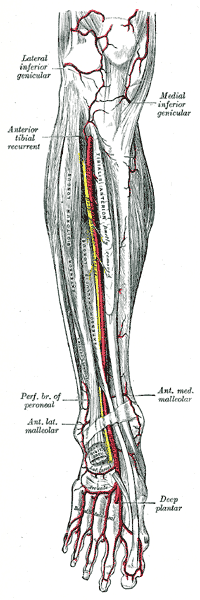| Dorsalis pedis artery | |
|---|---|
 Anterior tibial artery, dorsalis pedis artery and the muscles and bones of the leg (anterior view). | |
| Details | |
| Source | Anterior tibial artery |
| Branches | First dorsal metatarsal artery, deep plantar artery |
| Supplies | Dorsal surface of the foot |
| Identifiers | |
| Latin | arteria dorsalis pedis |
| TA98 | A12.2.16.048 |
| TA2 | 4714 |
| FMA | 43915 |
| Anatomical terminology | |
In human anatomy, the dorsalis pedis artery (dorsal artery of foot) is a blood vessel of the lower limb. It arises from the anterior tibial artery, and ends at the first intermetatarsal space (as the first dorsal metatarsal artery and the deep plantar artery). It carries oxygenated blood to the dorsal side of the foot. It is useful for taking a pulse. It is also at risk during anaesthesia of the deep peroneal nerve.